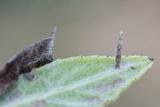Coleophora conyzae Zeller, 1868 Species
Last modified: Nov. 27, 2025, 8:08 p.m.
A very rare species in Belgium.
Details
- Classification
- Family: Coleophoridae > Genus: Coleophora > Species: Coleophora conyzae
- Vernacular names
- Heelblaadjeskokermot (NL), Spikenard case-bearer (EN), Alant-Sackmotte (DE)
- First mention in Belgium
- Wullaert S. 2010b. Coleophora conyzae (Lepidoptera: Coleophoridae), nieuw voor de Belgische fauna. — Phegea 38(2): 68–70. On page 68. view page
- Status
-
Native
Distribution
Imago
Wingspan 12–16 mm.
This is one of the larger species of Coleophoridae and the moth is reasonably well characterized by the forewings marked with white and yellow-brown streaks.
The antennae of this species are white and are, albeit only in (fresh) females, dappled with small black speckles.
Case
The larva lives at the underside of the leaf in a long, laterally compressed, and brown spatulate leaf case that is straight, tubular, and bivalved. Depending on the leaves of the hostplant used to construct this case, the latter can be hairy or, just the opposite, almost bare. The mouth angle is reasonably variable but is usually around 45°. The case can reach a length of 10–12 mm
See also bladmineerders.be.
Bionomics
The eggs are deposited at the underside of a leaf and the larvae also feed at that side of the leaf in a long and brown case. Remarkable is that the larva of this species constructs, with every moult, a new case. The old, abandoned one is left behind mostly at the leaf margin where the new case was built.
The caterpillar hibernates in its case and is full-grown by the end of May or early June and pupates on a stalk of the hostplant.
Flight periods
The moths are on the wing in July and August.
Observed on
- Host plant (species):
- Eupatorium cannabinum, Inula conyza and Pulicaria dysenterica
The larvae are oligophagous on Asteraceae but the preferred foodplants are Eupatorium cannabinum, Inula conyzae and Pulicaria dysenterica.


